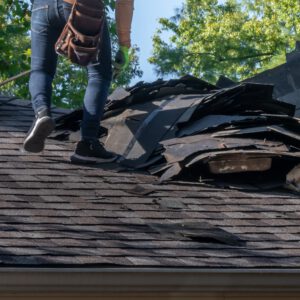The roof is an important part of your home, and it can be difficult to know what type is best for your house. There are many different types of roofing, including shingles, tile, and metal. Each has its own advantages and disadvantages.

The first step in installing a metal roof is to lay out the sheathing. Make sure to set a reference line that is square with the eave. For professional help, contact Red Stick Roofing Of Louisiana now!
The cost of roofing is a significant part of any home improvement project, and homeowners should take into account the price of materials when planning their budget. It is also important to consider a contractor’s fees and other expenses. Some of these include permit fees, waste removal and disposal charges, and roofing cleaning costs. Homeowners should also make sure to factor in any special roof features, such as chimneys and skylights, which can add up quickly.
The most significant cost variable for a new roof is the type of material, which can range from basic asphalt shingles to luxury copper. The cost of the materials will depend on the homeowner’s preferences, but a durable material will last longer and increase the value of the house. Additionally, homeowners should consider repairing or replacing flashing (the material around the chimney and the joints between roofing planes) and removing any moss or other debris that may be present on the roof.
Another factor that influences a home’s roofing cost is the location, as the cost of labor and materials differs between regions. For example, high-wind regions require metal shingles, while areas with heavy snowfall need snow guards and ice shields. Additionally, the size and structure of a roof can influence its cost, as more complex roofing can require more work and materials than simple shingles.
Before hiring a contractor, homeowners should read reviews and ask for references from previous clients. They should also check the contractor’s credentials, such as a license, Better Business Bureau rating, and active certificates of insurance-both workers’ compensation and liability. It is also important to understand the pricing model used by the contractor, which can affect the cost of a new roof. Typically, contractors will quote prices per “roofing square,” which is a unit of measure unique to the industry and helps them calculate the costs of materials, supplies, protective elements, and waste removal.
A homeowner should always build a 10% contingency into their budget to cover unexpected expenses. This amount will be more than enough to cover any unforeseen expenses, such as additional work, or the need for a temporary roof. If the contingency is not sufficient, homeowners can look into personal loans to cover the cost of a new roof. However, these types of loans typically have higher interest rates than equity mortgages.
Durability
Durability is one of the most important aspects of a home’s roof, and it affects how much money homeowners spend on maintenance and repairs. Choosing a durable roof that can withstand the elements is essential to reducing long-term costs. It’s also important to consider the lifespan and maintenance requirements of different roofing materials. For example, metal roofs are very durable and can last 50 years or more with minimal maintenance. Asphalt shingles are less durable and can last 15 to 20 years with regular maintenance.
Durable products are more affordable in the long run because they don’t need to be replaced as frequently. In addition, durability reduces waste by limiting the amount of material that needs to be discarded. This is important for the environment because it helps to limit the use of fossil fuels. Durability is also important for businesses because it allows them to focus on core activities rather than wasting resources on unnecessary expenses.
A durable product is one that can withstand a large amount of stress and force. It can withstand repeated stress and is able to return to its original shape without deforming or breaking. Durability is often compared to strength, but there are differences between the two. For example, a brick can be stronger than a steel beam, but it is not as durable.
The roof is the topmost part of a building that protects against rain, snow, sunlight, wind, and extremes of temperature. It can be constructed in a variety of forms, including flat, pitched, vaulted, and domed. It can also be designed for a particular aesthetic, environmental, or economic consideration. The cost of a new roof depends on its construction material, style, and layout. It can also be influenced by the type of ventilation system, skylights, or plumbing vents.
A new roof is an investment, and a homeowner must carefully evaluate the pros and cons of different options. For example, a metal roof can save the homeowner money on energy bills and repair costs. However, it may require more maintenance than a shingle roof. A homeowner should also consider the fire rating of the roof. For example, a class A fire-rated roof can save the homeowner money on insurance premiums and increase the value of the house.
Energy efficiency
Roofing is the construction and installation of a protective covering for the top of a building or structure. It protects against rain, snow, wind, and extreme temperatures. It can be built in a variety of forms, including flat and pitched roofs. Roofing can be constructed from a variety of materials, and it may include elements such as skylights and dormers.
Whether you’re looking to lower your energy bill, improve your home’s value, or both, an investment in a high-quality roofing system is a smart choice. However, before you make any big changes to your roof, be sure to consider how they’ll affect your budget and your energy efficiency goals. Small projects, like caulking windows or replacing light bulbs, can be great places to start before tackling bigger upgrades. Leaks should also be addressed, as they’ll impede all of your home’s energy efficiency efforts. Having leaking ductwork can add up to 25% to your energy bills.
